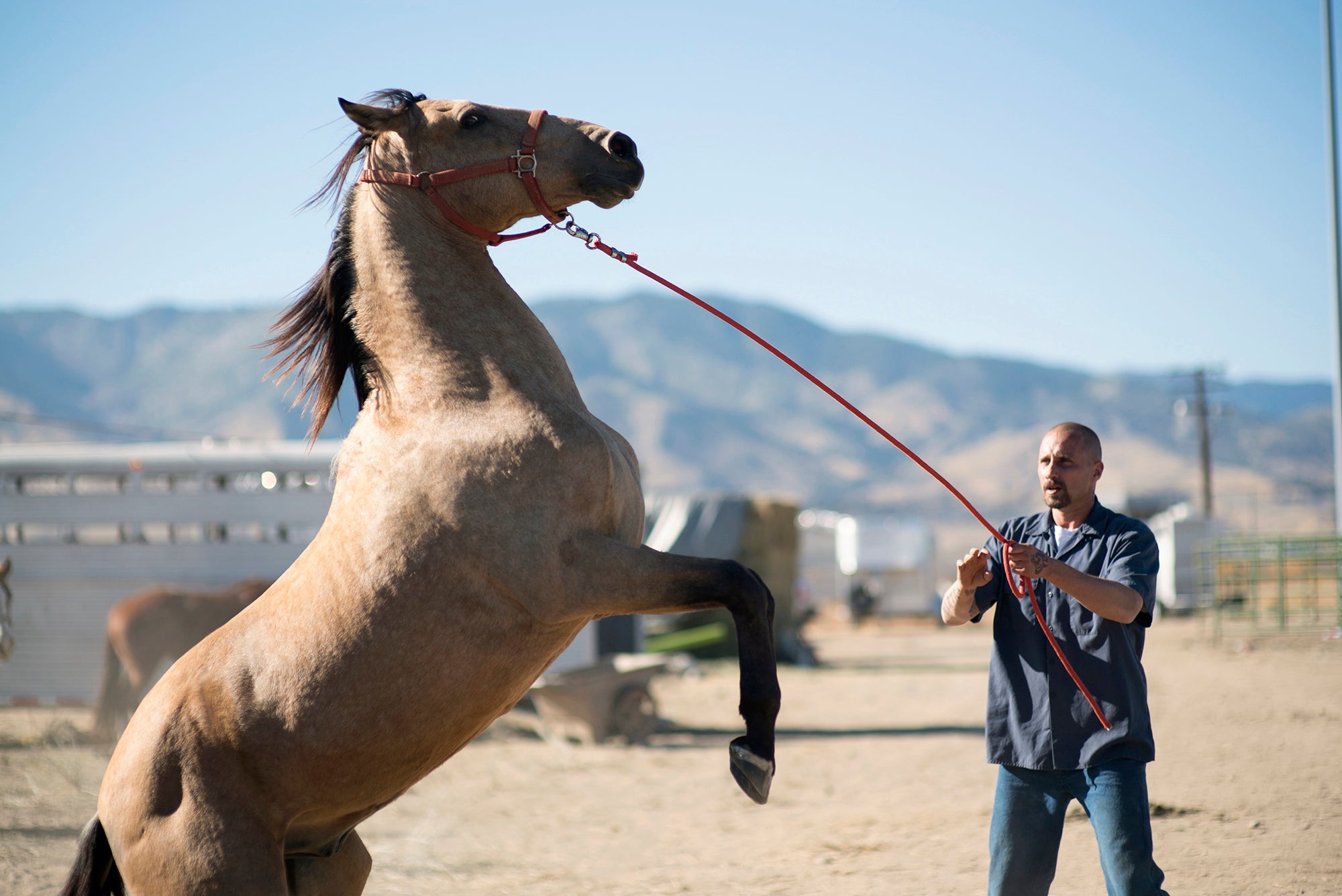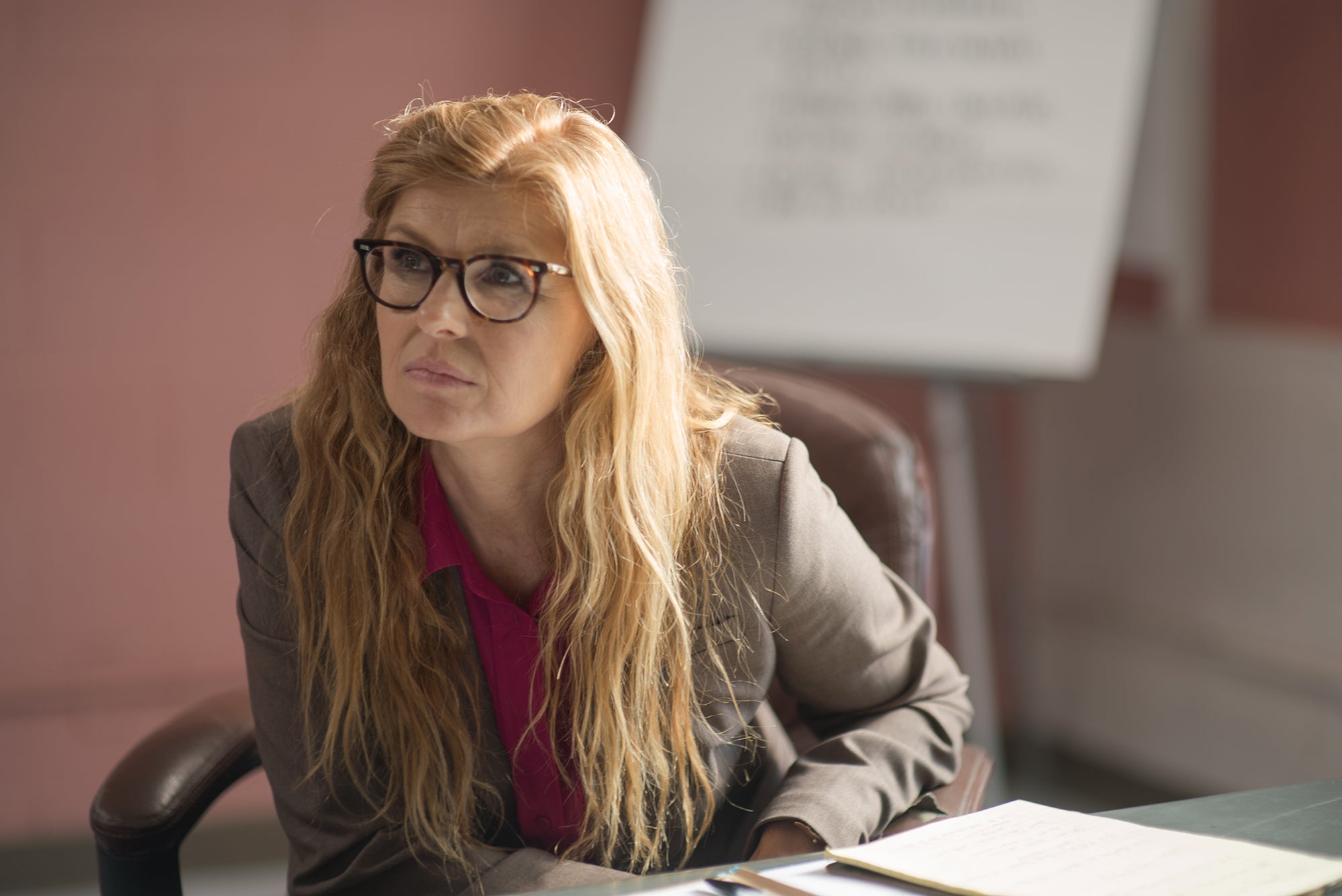Matthias Schoenaerts and director Laure de Clermont-Tonnerre talk Connie Britton, wild horses and Sundance.
Parisian writer-director Laure de Clermont-Tonnerre is telling a truly American story with The Mustang. Set against the backdrop of the industrial prison complex, the film casts Belgian actor Matthias Schoenaerts (The Danish Girl, Red Sparrow) as Roman, a prison inmate convicted of a violent crime who lands in a rehabilitation program focused on training wild horses. As Roman comes to terms with his own humanity, he grows close to a particularly unbreakable mustang. Too close, if you ask Schoenaerts. "I was scared as hell," he admits of filming opposite his equine co-star. In a sit-down with ET, he and Clermont-Tonnerre discuss casting Connie Britton and the scene that scared Schoenaerts the most.
ET: Rabbit [the Sundance short that inspired The Mustang] was about female inmates and rehabilitation therapy with small animals, namely a rabbit. When you were expanding it into a feature, what drew you to horses and centering the story on a male inmate?
Laure de Clermont-Tonnerre: Authenticity. The program is just with men. There's about 10 programs now in the West in America, and I observed and I researched this connection between men and horses. Obviously, if the program was involving women, maybe I would have [told that story]. But I just wanted to focus on what was really happening. It was very natural. I was like, "This is what's really happening. I want to portray this story."
I imagine that's also exciting as a writer-director. Oftentimes when a short gets the feature treatment, it remains a sort of one-to-one extension. You were able to revisit some of the same themes but tell a new story.
Clermont-Tonnerre: Yes, it was very, very interesting as a journey to dive into this same field for five years. I loved it. I felt that I was deepening and learning so much and specializing myself. And there's lots [more] to learn. But definitely, getting so immersed into a subject, that's how I want to approach my work.
And what drew you to this guy for this?
Matthias Schoenaerts: Eep!
Clermont-Tonnerre: [Laughs] I just bumped into him by accident.
Schoenaerts: "Eh, I'm looking for an actor and can't find one. You wanna do it or what?"
Clermont-Tonnerre: I was like, "OK, this one's fine." No, no. I knew his work, obviously, and I loved it. He has this quality that I was looking for for Roman, this deep mystery, this very vivid and explosive sensibility. It's very rare and it's very contained, but when it shines through, there's something that touches you in the depths of your heart. There's something in the emotion at the edge of his eyes that struck me. That this is Roman, this is the character I've been trying to find [for] five years. It was such a relief, in a way. Like, this is you! Now it is your responsibility.
Do you remember your impressions when you first read the script? Is this your role with the scarcest amount of dialogue?
Schoenaerts: Hmm, I don't know. Maybe! But I think the urgency. I think the relevance of the subject matter -- especially now that it's really on the forefront of the news -- there's an urgency to it. It contributes to the notion that transformation is possible in the most unlikely of places. To contribute to that notion -- that even the most seemingly lost cases could transform and could heal and could change -- is, to me, extremely valuable. Then, of course, the poetic dimension of it all. This is completely stimulated by the interaction that one individual has with a horse, the horse symbolizing sincerity and vulnerability. At the same time, there's a very devastating and powerful energy to what that animal symbolizes.
So, all of these things combined and there's also the mysterious element about what incarceration and isolation really is. Even though we've seen movies, we've seen documentaries, there's nothing that comes close to that real experience. What is that real experience? What is that reality? What is that emotional space that someone finds himself in when you go through that? We were lucky to visit three maximum security facilities where we had the chance to spend time with inmates, sit down with them for hours and hours and talk about their experience within the facility and also have them speak about what got them there and all that type of stuff. That gives you a real insight and helps you create an emotional silhouette for the character. Those are very specific places to try to understand and that helps you create that psychological structure, or whatever you want to call it, for the character.
And what was the process of creating the look of Roman, shaving Matthias' head, growing a goatee and adding the tattoos? What was it like seeing yourself as Roman for the first time?
Schoenaerts: It's something that grows gradually. I was already attached, like, two-and-a-half years before, so it's something that grows gradually. You start developing that image and then you start seeing him in your mind and then, all of a sudden, one day you wake up and you're like, "That's Roman. I just see it."
Clermont-Tonnerre: And also going together [to visit the] prisons, seeing a lot of portraits of men, a lot of different stories, a lot of different looks. There's definitely some elements that we were like, "Oh yeah, that'll be nice for Roman." Some little details. We explored several different looks, but we knew more or less what we wanted.


I know Susan Sarandon was originally attached before Connie Britton. How did that character change -- or how did being in those scenes evolve -- when Connie was brought on?
Clermont-Tonnerre: It didn't change. I was looking for this woman-- there's very few women in the film, so it's an important character -- who was also inspired by a woman that I dearly love and [who] really helped us to get us access to prison. She's the head of the health department--
Schoenaerts: Mental health department.
Clermont-Tonnerre: Yes, in the prison in Northern California. Her name is Kathleen O'Meara and I started my research with her. I loved and respected and admired so much what she was doing. I needed to [start] the film with this first interview with this therapist, and I went to different programs with Kathleen and explored different verbal rehabilitation and I thought that that character was very important to portray another dimension in the arc of Roman. You have, obviously, animal therapy, but it's also important to have this verbal therapy, where you can really sometimes have another [layer] of awareness of who you are.
That's a wonderful tribute to Kathleen, because you don't get much better than Connie Britton. She's phenomenal.
Schoenaerts: Absolutely.
Clermont-Tonnerre: We were really lucky to have her after Susan, in the end, couldn't make it anymore. Connie came on set and Kathleen was there and they exchanged a lot and Connie came so available and so open. It was wonderful to have her.
What was both of your familiarity with horses before this?
Schoenaerts: For me, it was pretty unknown territory. You know, maybe I had one or two riding lessons years before, so I was a very poor rider. Actually, I was not a rider at all, so I had to start from scratch. I always loved animals, but I grew up on the city side of things. You don't get to see a lot of horses. I think for you it was different. You had a passion for horses ever since you were a kid, no?
Clermont-Tonnerre: Yeah, I grew up riding, but I mean, I lived in Paris, so it's not that I could ride every day, you know? I really loved it and I wanted to train as a kid so I was trying to do it in the countryside or summer camp, but it was not something I could do every day. Also [it was] in a very European way, which is very different than what you can learn here about horsemanship, about connecting with a horse from the ground -- not automatically, like, competing or jumping. This connection is really about adapting yourself to the behavior of a wild horse and building a connection. I thought that was so profound and something that I could never learn in France. Never. So, I also kind of started from scratch.
I'm sure you worked with some pretty talented trainers on this, but what is the process of directing a horse? Especially in the more intense sequences where Matthias is with a horse who is freaking out. What are the logistics of filming those scenes?
Schoenaerts: It's just hoping nothing goes wrong. [Laughs] Because it's like being in the ring with Mike Tyson, times 10. That's the force of nature you're dealing with, the amount of strength and power and unpredictability. But luckily we have this amazing horse trainer who's like a conductor of the next level.
Clermont-Tonnerre: He knew, depending on the scene we were doing, exactly which horse he was willing to work with. And he had full control of the horse and the horse's reactions. We had moments of deep connection between Matthias and the horse, but it was a choreography between the camera, Matthias, the horse, and of course, the horse trainer. It was like this dance between all of them.
When you watch the film now, is there one scene you think, "I can't believe we actually made that work"? Or that you're just thankful to be on the other side of?
Clermont-Tonnerre: Putting those horses in the kitchen. Everyone was like, "Are you crazy?"
Schoenaerts: No, but that was scary! That was really scary. Because we needed those horses to also be a bit wild and stuff, and I'm like, "Man, we're in a small space, there's all metal objects, there's 12 horses, there's flickering lights, there's everything that can trigger the horse to get f**king nuts." Sorry for the profanity. If one horse starts to act funky, man, we're in hell. If that spreads? Like, 12 horses in the kitchen, if they get rowdy, people are gonna die. For real, that's the danger of it. You're gonna die in there.
Clermont-Tonnerre: It was definitely dangerous, but--
Schoenaerts: I was like, "I don't feel comfortable here!" I really didn't feel comfortable at all.
Clermont-Tonnerre: But those horses were not wild at all, obviously. They were very well-trained. They were the horse trainer's personal horses. He said, "It's possible we can do that scene, but only with my horses." Those horses were used to doing weird things like that because they are cinema horses and they are trained for it. As long as the horse trainer trusted the fact that we could do this scene safely, I was-- But I was not in the middle of the arena. [Laughs]
Schoenaerts: Yeah, you were safe behind the camera and we were, like, in the middle. I was like, Aughh!
Clermont-Tonnerre: I was behind my monitor, so it was safer than being where he was.
Schoenaerts: And you were like, "Yeah, let's do one more!" I was like, [Grumbling] "I'm going to kill the director..." I was really happy that that was over. Oh man, that was scary.
Looking back, from filming on through your premiere at Sundance, do you have a moment or a memory that defines the experience of The Mustang for you?
Schoenaerts: Laure, do you have one?
Clermont-Tonnerre: At Sundance, the response. There's nothing more rewarding than when people stand after watching your film and show so much warmth and so much emotion. This was the gift we had at Sundance, to see a full audience completely commit to the film. It was very special.
RELATED CONTENT:
